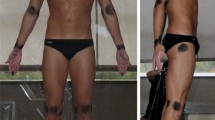Abstract
The aims of this study were (1) to evaluate changes in muscle activity associated with physiological fatigue and decreased swimming velocity (SV) during 200 m of front crawl swimming, and (2) to examine the relationship between the decreased SV and changes in kinematic or electromyogram parameters. Twenty swimmers participated in a 4 × 50-m swim test. The surface EMG of 11 muscles (7 in the upper limbs and 4 in the lower limbs) was measured and the mean amplitude value (MAV) for one stroke cycle was obtained. The SV and arm angular velocity (AAV) of shoulder flexion during the first (early stroke) and second (late stroke) half of the underwater arm stroke were analyzed using an underwater camera. The AAV, the MAV of flexor carpi ulnaris (FCU), biceps brachii (BB), and triceps brachii during the early stroke, and the MAV of rectus femoris decreased along with a decrease in SV. In contrast, the MAV of the pectoralis major (PM) increased significantly in the final 50 m. The rate of change in MAVs (ΔMAVs) of FCU, BB and latissimus dorsi during the early stroke, and ΔMAV of biceps femoris were significantly correlated with ΔSV and/or ΔAAV. Positive correlations were identified between ΔMAVs of several muscles. However, no negative correlations were observed between ΔMAVs. These results suggest that the decrease in SV was related to decreases in the activities of several muscles that coordinated with each other, and that a compensating strategy occurred between PM and other muscles in the final 50 m.







Similar content being viewed by others
References
Aujouannet YA, Bonifazi M, Hintzy F, Vuillerme N, Rouard AH (2006) Effects of a high-intensity swim test on kinematic parameters in high-level athletes. Appl Physiol Nutr Metabol 31:150–158
Bonifazi M, Martelli G, Marugo L, Sardella F, Carli G (1993) Blood lactate accumulation in top level swimmers following competition. J Sports Med Phys Fitness 33:13–18
Caty V, Aujouannet YA, Hintzy F, Bonifazi M, Clarys JP, Rouard AH (2007) Wrist stabilisation and forearm muscle coactivation during freestyle swimming. J Electromyogr Kinesiol 17:285–291
Chollet D, Chalies S, Chatard JC (2000) New Index of coordination for the crawl: description and usefulness. Int J Sports Med 20:54–59
Clarys JP, Rouard AH (1996) The frontcrawl downsweep: shoulder protection and/or performance inhibition. J Sports Med Phys Fitness 36:121–126
Figueiredo P, Zamparo P, Sousa A, Vilas-Boas JP, Fernandes RJ (2011) An energy balance of the 200 m front crawl race. Eur J Appl Physiol 111:767–777
Huot-Marchand F, Nesi X, Sidney M, Alberty M, Pelayo P (2005) Variations of stroking parameters associated with 200-m competitive performance improvement in top-standard front crawl swimmers. Sports Biomech 4:89–100
Kouzaki M, Shinohara M, Masani K, Kanehisa H, Fukunaga T (2002) Alternate muscle activity observed between knee extensor synergists during low-level sustained contractions. J Appl Physiol 93:675–684
Lecrivain G, Payton C, Slaouti A, Kennedy I (2010) Effect of body roll amplitude and arm rotation speed on propulsion of arm amputee swimmers. J Biomech 43:1111–1117
Lobjois R, Benguigui N, Bertsch J (2005) Aging and tennis playing in a coincidence-timing task with an accelerating object: the role of visuomotor delay. Res Q Exerc Sport 76:398–406
Maglischo EW (2003) Swimming fastest. Human kinetics, Champaign
Perotto AO (1996) Anatomical guide for the electromyographer: the limbs and trunk. Charles C Thomas publisher, Springfield, pp 54–193
Pink M, Perry J, Browne A, Scovazzo ML, Kerrigan J (1991) The normal shoulder during freestyle swimming: an electromyographic and cinematographic analysis of twelve muscles. Am J Sports Med 19:569–576
Rouard AH, Billat RP (1990) Influences of sex and level of performance on freestyle stroke: an electromyography and kinematic study. Int J Sports Med 11:150–155
Rouard AH, Clarys JP (1995) Cocontraction in the elbow and shoulder muscles during rapid cyclic movements in an aquatic environment. J Electromyogr Kinesiol 5:177–183
Rouard AH, Billat RP, Deschodt V, Clarys JP (1997) Muscular activations during repetitions of sculling movements up to exhaustion in swimming. Arch Physiol Biochem 105:655–662
Schnitzler C, Seifert L, Ernwein V, Chollet D (2008) Arm coordination adaptations assessment in swimming. Int J Sports Med 29:480–486
Seifert L, Chollet D, Rouard A (2007) Swimming constraints and arm coordination. Hum Mov Sci 26:68–86
Stirn I, Jarm T, Kapus V, Strojnik V (2011) Evaluation of muscle fatigue during 100-m front crawl. Eur J Appl Physiol 111:101–113
Szucs K, Navalgund A, Borstad JD (2009) Scapular muscle activation and co-activation following a fatigue task. Med Biol Eng Comput 47:487–495
Wakayoshi K, Moritani T, Mutoh Y, Miyashita M (1994) Electromyographic evidence of selective muscle fatigue during competitive swimming. In: Miyashita M, Mutoh Y, Richardson AB (eds) Medicine and Sports Science 39, pp 16–23
Wakeling JM, Blake OM, Chan HK (2010) Muscle coordination is key to the power output and mechanical efficiency of limb movements. J Exp Biol 213:487–492
Acknowledgments
We extend our deepest gratitude to Professor Yoshinori Nishijima (Osaka Kyoiku University), Mr. Tatsuo Kato (Tokiwakai Gakuen University), and Mr. Motoyoshi Masuda (Konami Sports and Life) for their support with the data collection in this study. This study was supported by MEXT KAKENHI (Grant-in-Aid for Young Scientists (B): 16700458).
Conflict of interest
The authors declare that they have no conflict of interest.
Author information
Authors and Affiliations
Corresponding author
Additional information
Communicated by Guido Ferretti.
Electronic supplementary material
Below is the link to the electronic supplementary material.
Rights and permissions
About this article
Cite this article
Ikuta, Y., Matsuda, Y., Yamada, Y. et al. Relationship between decreased swimming velocity and muscle activity during 200-m front crawl. Eur J Appl Physiol 112, 3417–3429 (2012). https://doi.org/10.1007/s00421-012-2321-0
Received:
Accepted:
Published:
Issue Date:
DOI: https://doi.org/10.1007/s00421-012-2321-0




